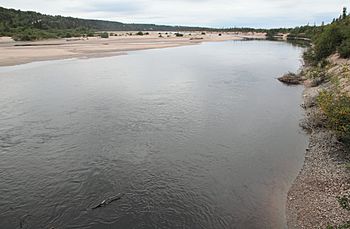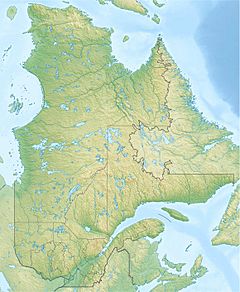Pentecôte River facts for kids
Quick facts for kids Pentecôte River |
|
|---|---|

The river near the point where it joins the Saint Lawrence
|
|
| Native name | Rivière Pentecôte |
| Country | Canada |
| Province | Quebec |
| Region | Côte-Nord |
| RCM | Sept-Rivières |
| Municipality | Port-Cartier |
| Physical characteristics | |
| Main source | Lake Bourgeois 50°30′11″N 67°34′06″W / 50.503023°N 67.568373°W |
| River mouth | Gulf of Saint Lawrence 49°46′48″N 67°09′52″W / 49.78°N 67.1644444°W |
| Length | 124 kilometres (77 mi) |
| Basin features | |
| Basin size | 1,971 square kilometres (761 sq mi) |
| NRC id | EHOZH |
The Pentecôte River (called Rivière Pentecôte in French) is a river in the Côte-Nord region of Quebec, Canada. It flows into the Gulf of Saint Lawrence near the town of Rivière-Pentecôte. This important river is found within the Port-Cartier–Sept-Îles Wildlife Reserve.
Contents
Where is the Pentecôte River?
The Pentecôte River is located in the municipality of Port-Cartier. This area is part of the Sept-Rivières Regional County Municipality in Quebec.
What does the name Pentecôte mean?
The local Innu people used to call the river Mistecapiu. This name means "Steep Rock". The name "Pentecôte" comes from a Christian holiday called Pentecost. It is believed that explorer Jacques Cartier arrived in this area on that special day.
Old maps and documents show different names for the river. In 1685, Louis Jolliet called it "Pannecoste". A map from 1695 by Deshayes showed it as "Rivière de la Pentecoste". In 1744, cartographer Bellin also mentioned it as "R. Michigabiou or R. de la Pentecôte".
Nature and Wildlife Around the River
The area around the Pentecôte River has a cool climate. Near the river's mouth, the average temperature is about 1.9°C (35.4°F) each year. It also gets about 1154 mm (45 inches) of rain annually. Further inland, it's a bit colder and wetter.
Forests and Plants
The river flows through a large forest area. Most of the trees are black spruce, which is a type of evergreen tree. You can also find balsam fir, white birch, and trembling aspen. Near the coast, there are more fir and white spruce trees.
Fish and Aquatic Life
Many types of fish live in the Pentecôte River.
- Atlantic salmon use the river to lay their eggs. Young salmon stay in the river for 2 to 4 years. They mostly eat insect larvae. After growing, they swim to the ocean and travel towards Greenland. People are allowed to fish for salmon here, but there are rules to follow.
- Anadromous brook trout, also known as sea trout, also live here. They feed near the river's mouth. Sometimes, they swim several kilometers upstream to lay their eggs in shallow water.
- Other fish found in the river include rainbow smelt, American eel, and different kinds of sucker fish. Rainbow trout are rare but have been seen.
The River's Journey
The Pentecôte River is 124 kilometers (77 miles) long. It starts in Lake Bourgeois. This lake is one of many along the Cartier Railway route. From there, the river flows southeast. It finally empties into the Gulf of Saint Lawrence.
River Features
- V-shaped Valley: For over 25 kilometers (15.5 miles), the river flows through a deep V-shaped valley. The sides of this valley can be over 400 meters (1,300 feet) high!
- Lake Pentecôte: The river passes through Lake Pentecôte, which is 17 kilometers (10.5 miles) long.
- Navigable Parts: Small boats can travel on the river for about 4 kilometers (2.5 miles) from its mouth. Canoes can go further, about 13 kilometers (8 miles), up to the Quatorze Arpents Fall.
- Water Flow: The river drops 701 meters (2,300 feet) from its source to its mouth. On average, about 57.3 cubic meters (2,024 cubic feet) of water flow out of the river every second.
- Tributaries: Smaller rivers that flow into the Pentecôte River include the Coude, Caotibi, De l’Est, Aux Couleuvres, Profonde, Aux Crapauds, Dubé, and Du Pont rivers.
- River Mouth: Near the end of its journey, the river makes two big bends. It then enters the Gulf of Saint Lawrence through a narrow opening, only 75 meters (246 feet) wide.
A Changing River Mouth?
In 2019, a report warned that the river's mouth might change. The river flows next to a narrow strip of sand that separates it from the sea. This sand strip is getting smaller because of the river and ocean waves. If a big storm or flood happens, the river could break through the sand. This would move the river's mouth more than 2 kilometers (1.2 miles) south. If this happens, the part of the river that is left behind could turn into a salty marsh.
The River's Watershed
The Pentecôte River's watershed covers an area of 1,980 square kilometers (764 square miles). A watershed is all the land where water drains into a specific river. This watershed is long and narrow, about 100 kilometers (62 miles) from north to south and 20 kilometers (12.4 miles) wide.
Landscape Features
- Coastal Plain: Along the Gulf of Saint Lawrence, there is a flat coastal plain. It is up to 9 kilometers (5.6 miles) wide and about 100 meters (328 feet) above sea level.
- Hills and Plateaus: Inland from the plain, there are rounded rocky hills up to 500 meters (1,640 feet) high. Further north, the land becomes a rocky plateau with steep slopes. The highest point in the watershed is 792 meters (2,598 feet).
- Rock and Soil: The area has many types of ancient rocks. Higher areas often have thin soil with lots of exposed rock. Valleys often have thick layers of sand and gravel left behind by glaciers. The coastal plain has a lot of clay and silt, covered by sand.
Lakes of the Pentecôte River System
Lakes and streams make up about 7% of the watershed. Wetlands, which are marshy areas, cover about 0.95% and are mostly found on the flat coastal plain. The main lakes in the watershed are long and stretch from north to south.
Here are some of the main lakes:
| Lake | Area | Coordinates |
|---|---|---|
| Lac Bourgeois | 11.3 square kilometres (4.4 sq mi) | 50°35′33″N 67°31′48″W / 50.5925°N 67.5300°W |
| Lac Simard / Petit lac Simard | 5.65 square kilometres (2.18 sq mi) | 50°18′17″N 67°27′53″W / 50.3047°N 67.4647°W |
| Lac Paul-Côté | 4.82 square kilometres (1.86 sq mi) | 49°54′38″N 67°27′40″W / 49.9105°N 67.4611°W |
| Lac Pentecôte | 21.2 square kilometres (8.2 sq mi) | 49°52′19″N 67°20′08″W / 49.8719°N 67.3355°W |
Lake Pentecôte
Lake Pentecôte is the largest lake in the river system. It covers an area of 21.2 square kilometers (8.2 square miles). It is very long and narrow, stretching almost 16 kilometers (10 miles) from north to south. In some places, its sides rise almost 300 meters (984 feet) high. The lake was formed when a glacial valley filled with water. The river flows out of the lake about 17 kilometers (10.5 miles) from its mouth. Lake Pentecôte is a great place for fishing, but you need a boat to explore it.
Lake Bourgeois
Lake Bourgeois is where the Pentecôte River begins. We don't know for sure how it got its name. It is located just south of Grand lac Caotibi, and the two lakes are almost connected. The Cartier Railway runs along the eastern shore of Lake Bourgeois as it heads north. The land around the northern part of Lake Bourgeois is mostly covered by forests. Some of the forest east of the southern part of the lake is protected.
See also
 In Spanish: Río Pentecôte para niños
In Spanish: Río Pentecôte para niños


